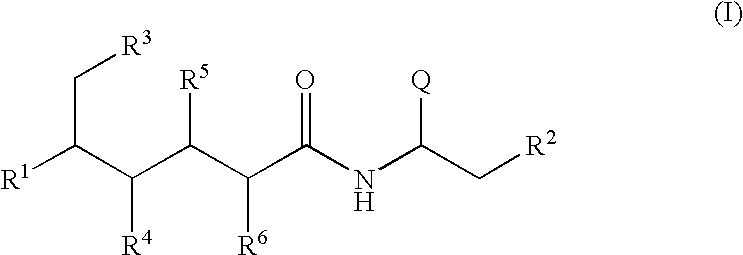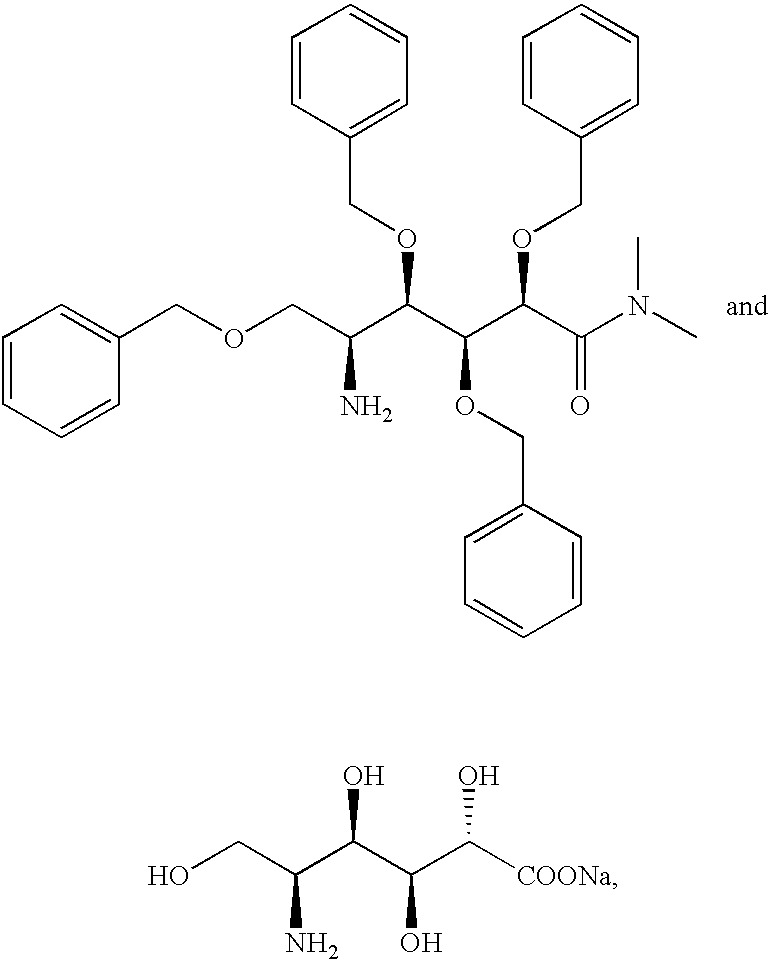Polyol-amino acid compounds having anti-helicobacter pylori activity
a technology of polyol-amino acid compounds and helicobacter pylori, which is applied in the field of new medicinal agents to achieve the effect of reducing the incidence of adverse reactions and high antibacterial activity
- Summary
- Abstract
- Description
- Claims
- Application Information
AI Technical Summary
Benefits of technology
Problems solved by technology
Method used
Image
Examples
example 2
(S)-3-[(2S,3R,4R,5S)-2,3,4,6-tetrahydroxy-5-(L-valyl-L-valyl-L-leucyl)aminohexanoyl]amino-3-phenylpropionic acid (HC-70I, compound 1)
A loopful of Bacillus sp. HC-70 fully grown on a slant medium composed of glucose 0.1%, tryptone 0.5%, yeast extract 0.25%, and agar 1.5% was used to inoculate a sterilized 2-L Sakaguchi flask containing 500 mL of a seed culture medium (pH 7.0) composed of glucose 2.0%, soluble starch 3.0%, corn steep liquor 0.3%, soybean flour 1.0%, polypeptone 0.5%, yeast extract 0.1%, oatmeal agar 0.2%, sodium chloride 0.3%, and precipitated calcium carbonate 0.5% and incubation was carried out on a reciprocating shaker at 24.degree. C. for 2 days. This culture, 500 mL, was transferred to a 200-L fermenter containing 120 L of a production medium (pH 6.5) composed of glucose 0.5%, dextrin 5.0%, soybean meal 3.5%, yeast extract 0.5%, precipitated calcium carbonate 0.7%, ACTOCOL.TM. 31-56 (Takeda Chemical Industries Ltd.) 0.05%, and silicone oil 0.05% and was incubated...
example 3
(S)-3-[(2S,3R,4R,5S)-2,3,4,6-tetrahydroxy-5-(L-valyl-L-leucyl)aminohexanoyl]amino-3-phenylpropionate hydrochloride (HC-70II monohydrochloride, compound 4)
To HC-70II (Compound 2; 200 mg) were added 0.1N-hydrochloric acid (3.4 mL) and water (60 mL), and the mixture was warmed to prepare a solution. This solution was filtered through DISMIC-25CS (0.45 .mu.m, Toyo Roshi) and the filtrate was freeze-dried to provide HC-70II monohydrochloride (Compound 4; 199 mg).
Elemental analysis (for C.sub.26 H.sub.42 N.sub.4 O.sub.9.HCl.2.5H.sub.2 O) Found: C, 48.93; H, 7.18; N, 8.86; Cl, 5.64 Calcd.: C, 49.09; H, 7.61; N, 8.81; Cl, 5.57
example 4
(S)-3-[(2S,3R,4R,5S)-5-amino-2,3,4,6-tetrahydroxyhexanoyl]amino-3-phenylpropionic acid (compound 5)
In phosphate buffer (40 mM, pH 8; 47.5 mL) was dissolved HC-70III (Compound 3; 190 mg) followed by addition of an aqueous solution of cobalt chloride (1 M, 0.19 mL) and Actinase E (19 mg, Kaken Pharmaceutical Co.), and the reaction was carried out at 37.degree. C. for 2 hours. This reaction mixture was filtered through a filter paper (No. 2, Toyo Roshi) and the filtrate was subjected to HP-20 (50 mL) column chromatography. The column was washed with water (50 mL) and serial elution was carried out with water (100 mL) and 20% (v / v) isopropyl alcohol / H.sub.2 O (200 mL). The eluate was concentrated and freeze-dried to provide crude powders (149 mg).
The above crude powders were subjected to preparative HPLC [column: YMC-Pack SH-363-15, ODS (YMC), mobile phase: 5% (v / v) acetonitrile / 0.02 M phosphate buffer (pH 4.5), flow rate: 12 mL / min]. The 400 to 600 mL fractions were pooled, adjusted to...
PUM
| Property | Measurement | Unit |
|---|---|---|
| Mass | aaaaa | aaaaa |
| Mass | aaaaa | aaaaa |
| Mass | aaaaa | aaaaa |
Abstract
Description
Claims
Application Information
 Login to View More
Login to View More - R&D
- Intellectual Property
- Life Sciences
- Materials
- Tech Scout
- Unparalleled Data Quality
- Higher Quality Content
- 60% Fewer Hallucinations
Browse by: Latest US Patents, China's latest patents, Technical Efficacy Thesaurus, Application Domain, Technology Topic, Popular Technical Reports.
© 2025 PatSnap. All rights reserved.Legal|Privacy policy|Modern Slavery Act Transparency Statement|Sitemap|About US| Contact US: help@patsnap.com



